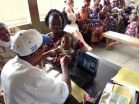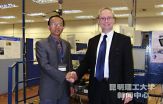(Press-News.org) Anti-odour clothing may not be living up to its promise, and an ALES researcher is saying it
could all be a matter of how the product was tested.
In two separate experiments, Human Ecology researcher Rachel McQueen and her team found that some antimicrobial textiles were far more effective at performing their advertised tasks in the lab than in testing on humans. In one experiment, the fabrics were designed to help lower the risk of infection; in the second, the fabric was treated with a silver compound, which can be marketed preventing odour in clothing.
"We aren't necessarily seeing the same results in the lab about antimicrobial activity translating into antimicrobial activity when we're wearing them next to our bodies in real life," she said.
The first experiment analyzed the effectiveness of three different textiles coated in antimicrobials triclosan, a zinc pyrithione derivative and a silver chloride-titanium dioxide compound. After putting the fabric on people's arms under plastic film for 24 hours, the silver-chloride titanium dioxide compound hardly eliminated any bacteria. Overall, they found the in vivo — tested on humans — results were not comparable with in vitro — tested in the lab — results in how they prevented microorganisms from surviving in the textile.
The second test had similar results, and tested whether polyester textiles treated with bioactive concentrations of an antimicrobial silver chloride compound reduced armpit odour and bacterial populations. Although lab testing showed antimicrobial activity, the treated fabrics did not lower odour or bacterial intensity in in vivo testing.
McQueen said that anything from sweat to the proteins in the human body can disrupt the antimicrobial properties of a fabric.
"In reality, when it goes to the point that it gets put on a textile... it may not have the same level of effectiveness as the ones they studied," she said.
McQueen said these findings highlight the importance of in vivo testing, which is less common than in vitro testing, in textile product development. But, because the textiles appear to be effective at reducing bacteria in the lab, she said they may be advertised as being anti-odourous, although they may not necessarily be so when actually worn.
So, for now, McQueen suggests thinking twice before trusting textile's advertised claims.
"It's just a real spectrum to how effective they may truly be. So I'd probably say, from a consumer's point of view, if you're actually buying something that says it's antimicrobial, it may not be," she said. "I think that's important to consider in relation to a lot of claims made about textiles, that is, to be skeptical about the claims marketers make."
McQueen's research was recently published in the International Journal of Clothing Science and Technology.
INFORMATION:
Smelly discovery challenges effectiveness of antimicrobial textiles
Textile scientist finds lab results don't add up with tests on people
2014-09-26
ELSE PRESS RELEASES FROM THIS DATE:
Children with autism are more sedentary than their peers, new OSU study shows
2014-09-26
CORVALLIS, Ore. – A new Oregon State University study of children with autism found that they are more sedentary than their typically-developing peers, averaging 50 minutes less a day of moderate physical activity and 70 minutes more each day sitting.
The small study of 29 children, some with autism and some without, showed that children with autism perform as well as their typical peers on fitness assessments such as body mass index, aerobic fitness levels and flexibility. The results warrant expanding the study to a larger group of children, said Megan MacDonald, an ...
Poor fish harvests more frequent now off California coast
2014-09-26
As a child in southern California, Ryan Rykaczewski spent a fair amount of time on his grandfather's boat, fishing with him off the Pacific coast near Los Angeles. At the time, he didn't think there was much rhyme or reason to their luck on the water.
"Sometimes we'd catch a lot of fish and sometimes we didn't," he says. "I just thought it was chaotic, that we could never understand what was going on."
But education changed his mind. Now an oceanographer and assistant professor at the University of South Carolina, he's working to understand the many factors that determine ...
Scanning babies' fingerprints could save lives
2014-09-26
Each year 2.5 million children die worldwide because they do not receive life-saving vaccinations at the appropriate time.
Anil Jain, Michigan State University professor, is developing a fingerprint-based recognition method to track vaccination schedules for infants and toddlers, which will increase immunization coverage and save lives.
To increase coverage, the vaccines must be recorded and tracked. The traditional tracking method is for parents to keep a paper document. But in developing countries, keeping track of a baby's vaccine schedule on paper is largely ineffective, ...
Decision analysis can help women make choices about breast reconstruction
2014-09-26
September 26, 2014 – Decision analysis techniques can help surgeons and patients evaluate alternatives for breast reconstruction—leading to a "good decision" that reflects the woman's preferences and values, according to an article in the October issue of Plastic and Reconstructive Surgery®, the official medical journal of the American Society of Plastic Surgeons (ASPS).
The special topic article by Mia K. Markey, PhD, and colleagues of The University of Texas at Austin and The University of Texas MD Anderson Cancer Center, Houston, introduces plastic surgeons to the ...
New tool assesses skill development in robotic microsurgery, reports Plastic and Reconstructive Surgery
2014-09-26
September 26, 2014 – A new standardized assessment provides a useful tool for tracking surgeons' progress as they develop the skills needed to perform robot-assisted microsurgery, reports a study in the October issue of Plastic and Reconstructive Surgery®, the official medical journal of the American Society of Plastic Surgeons (ASPS).
"The Structured Assessment of Robotic Microsurgical Skills (SARMS) is the first validated instrument for assessing robotic microsurgical skills," according to the report by ASPS Member Surgeon Dr Jesse C. Selber of the University of Texas ...
Disease without borders
2014-09-26
In a paper published this week online in Global Society, researchers with University of California, San Diego School of Medicine and the Urban Studies and Planning Program, also at UC San Diego, present a bioregional guide that merges place-based (territorial) city planning and ecosystem management along the United States-Mexico border as way to improve human and environmental health.
Issues like climate change, economic crisis, natural disasters and disease outbreaks do not stop at national borders, compelling public health officials, academics and researchers to think ...
Cardiology leaders call for global prevention of heart disease, stroke
2014-09-26
WASHINGTON (Sept. 29, 2014) — Heart disease and stroke contribute to 30 percent of global deaths, more than all infectious and parasitic diseases combined, and 11 cardiovascular organizations are calling for the United Nations to address prevention of heart disease and other non-communicable diseases.
In a statement published in the Journal of the American College of Cardiology and other cardiology journals, the World Heart Federation's Global Cardiovascular Disease Taskforce—which is comprised of cardiologists and health advocates from the World Heart Federation, African ...
Progress in materials science
2014-09-26
RESEARCHERS at the University of Huddersfield have collaborated with a colleague at a leading Chinese university to produce a detailed appraisal of a complex new welding technique that could be increasingly valuable to modern industry.
Professor Andrew Ball (pictured below) and his colleague Dr Fengshou Gu, of the University of Huddersfield's Centre for Efficiency and Performance Engineering, teamed up with Professor Xiaocong He of Kunming University of Science and Technology's (KUST) Innovative Manufacturing Research Centre in order to investigate the technique ...
Severe periodontitis: Sixth most prevalent health condition in the world
2014-09-26
Alexandria, Va., USA – The International and American Associations for Dental Research (IADR/AADR) have published a paper titled "Global Burden of Periodontitis: A Systematic Review and Meta-Regression." The manuscript, by lead researcher Wagner Marcenes (Queen Mary University of London, Institute of Dentistry, Barts and The London School) is published in the OnlineFirst portion of the IADR/AADR Journal of Dental Research (JDR).
The purpose of this study was to consolidate all epidemiological data about severe periodontitis and subsequently to generate internally consistent ...
Morphed images of Hollywood celebrities reveal how neurons make up your mind
2014-09-26
An international team of scientists, involving Professor Rodrigo Quian Quiroga, director of the Centre for Systems Neuroscience and Head of Bioengineering at the University of Leicester, has shown how individual neurons in the human brain react to ambiguous morphed faces.
For this, the researchers used images of celebrities, such as Angelina Jolie and Halle Berry, morphed together to create an ambiguous face which test subjects were asked to identify.
The study found that for the same ambiguous images, the neurons fired according to the subjective perception by the ...
LAST 30 PRESS RELEASES:
SIMJ announces global collaborative book project in commemoration of its 75th anniversary
Air pollution exposure and birth weight
Obstructive sleep apnea risk and mental health conditions among older adults
How talking slows eye movements behind the wheel
The Ceramic Society of Japan’s Oxoate Ceramics Research Association launches new international book project
Heart-brain connection: international study reveals the role of the vagus nerve in keeping the heart young
Researchers identify Rb1 as a predictive biomarker for a new therapeutic strategy in some breast cancers
Survey reveals ethical gaps slowing AI adoption in pediatric surgery
Stimulant ADHD medications work differently than thought
AI overestimates how smart people are, according to HSE economists
HSE researchers create genome-wide map of quadruplexes
Scientists boost cell "powerhouses" to burn more calories
Automatic label checking: The missing step in making reliable medical AI
Low daily alcohol intake linked to 50% heightened mouth cancer risk in India
American Meteorological Society announces Rick Spinrad as 2026 President-Elect
Biomass-based carbon capture spotlighted in newly released global climate webinar recording
Illuminating invisible nano pollutants: advanced bioimaging tracks the full journey of emerging nanoscale contaminants in living systems
How does age affect recovery from spinal cord injury?
Novel AI tool offers prognosis for patients with head and neck cancer
Fathers’ microplastic exposure tied to their children’s metabolic problems
Research validates laboratory model for studying high-grade serous ovarian cancer
SIR 2026 delivers transformative breakthroughs in minimally invasive medicine to improve patient care
Stem Cell Reports most downloaded papers of 2025 highlight the breadth and impact of stem cell research
Oxford-led study estimates NHS spends around 3% of its primary and secondary care budget on the health impacts of heat and cold in England
A researcher’s long quest leads to a smart composite breakthrough
Urban wild bees act as “microbial sensors” of city health.
New study finds where you live affects recovery after a hip fracture
Forecasting the impact of fully automated vehicle adoption on US road traffic injuries
Alcohol-related hospitalizations from 2016 to 2022
Semaglutide and hospitalizations in patients with obesity and established cardiovascular disease
[Press-News.org] Smelly discovery challenges effectiveness of antimicrobial textilesTextile scientist finds lab results don't add up with tests on people



